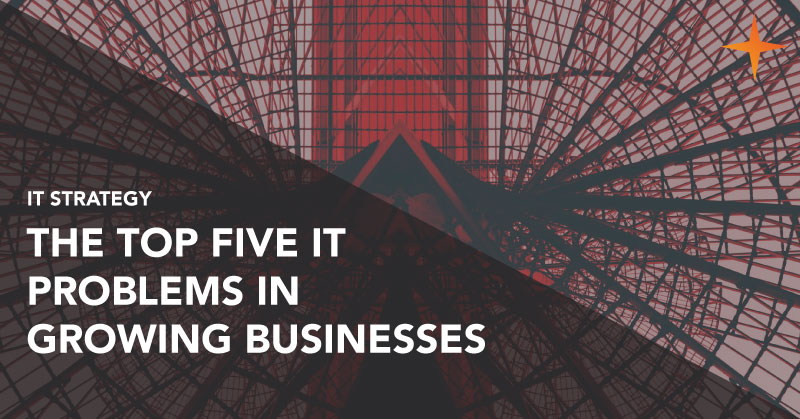Blog
The top 5 IT support problems for growing businesses and how to fix them
April 19th, 2017

IT is critical for the day-to-day operations of the majority of businesses, and when used effectively it has the potential to drive dramatic growth. Though small businesses often do not have a large budget, there are areas of their IT management that can easily be improved – without the need to invest a lot of financial resources. Here are five common IT problems facing SMEs, and how to resolve them.
1. Migration and integration pain
New technologies do not always slot in well with older systems and applications, and this can result in duplicate data entry and other inefficiencies. If you don’t have the time, experience or resources to deal with more complex migrations then the IT project that was supposed to transform your business can end up being painful and time-consuming. Thorough planning before implementation and a migration strategy can help your business to avoid these issues. Alternatively reach out to a provider who specialises in zero downtime migrations, and who has the experience and dedicated resources to make the change as painless as possible.
2. Reactive approach
“If you’re proactive you focus on preparing. If you’re reactive you focus on repairing”. Systems need regular maintenance to ensure they run properly and securely. Without that issues can quickly turn into expensive and time-consuming emergencies. When there is a process for tracking issues, it allows IT teams or providers to analyse and identify trends. Upon further inspection of a trend, they may find that the issue is a symptom of a greater problem. Instead of solving the same recurring issue every time it crops up, take a proactive approach and find a solution to the root cause. This would make the issue go away for good, and allow your business to be more productive – instead of firefighting problems.
3. Business strategy and IT strategy disconnect
Business leaders are often disconnected from IT and can fail to see how technology fits into the bigger picture. Others can go even further. Viewing IT simply as a necessary evil that demands spend without delivering any real value. If your business views IT in this unfavourable light then you are missing out on a world of potential, likely making it harder to achieve your goals. If you’re planning on doubling the size of your business in the next three years but don’t inform IT, how will you ensure you have the infrastructure, systems and processes in place to support that growth, in that timeframe. When IT and business strategy are truly aligned, and working in partnership, a business can scale without limits.
4. Increasing security risks
This not just an issue for SMEs, but the number of cyber-attacks on growing businesses is rising. SMEs are often more at risk simply because they don’t believe they are a target for a cyber-criminal. Communications, customer information and HR records are all of interest to hackers, as they can exploit them for financial gain. The reputational damage a successful breach causes is enough to severely weaken – and in some cases permanently destroy – even the strongest of brands.
Of course, there’s a number of security solutions to consider. But in order to truly mitigate the risks, you need to think beyond technology. Staff training is one of the most valuable investments a small business can make. Your people are your first line of defence. If they can spot the signs of attack, they can be an effective barrier against cyber-criminals.
You should also look at undertaking certifications such as Cyber Essentials and Cyber Essentials Plus. If you’re really serious about security, you should look at ISO 27001 accreditation. These certifications will ensure your business has the appropriate security measures in place and demonstrate to customers that you take cyber-security seriously.
5. Keeping up with change & innovation
The pace of change in the IT sector is incredibly fast. It seems that every day there is a new solution that will transform your business. Not only do you need to keep up with all the changes, but you also need to be able to spot the necessities among the gimmicks.
Ideally, you need to have someone in a management role who deals directly with IT advancement and works consistently with other departments to ensure seamless integration. However this can be a challenge for small businesses who lack resources, so another alternative is to work with an IT support provider who have the resources, expertise to keep up with technological change and who can advise you on making the right investments. A quality IT support provider will make recommendations backed by a clear business case. Not just use a new release as a sales opportunity.
Are you paying too much for IT support?
You’ve probably heard the old adage “you get what you pay for”, meaning if you choose a cheap product, you can probably expect problems. But is this true when it comes to IT support? Well, yes… yes it is. With one of the most well-known benefits of outsourced IT support being its’ cost-effectiveness, many companies rush […]
Co-sourced IT Support Guide: The top 5 benefits
Outsourced IT support and internal IT teams both have their pros and cons, but there is a third option available to businesses and that is co-sourced IT support. Co-sourcing is a flexible approach which allows you to supplement your internal IT department with external resources, which can alleviate the team’s workload and simultaneously provide you […]
How can I use IT to improve profit margins? | The QuoStar Q&A
Question “Coronavirus has had a significant impact on my business, and I need to find ways to protect our profit margins without harming the business longer-term. Our IT systems definitely helped us stay up and running during the lockdown, so I know I can’t really cut spending dramatically but is there a way I can use our systems and technology more effectively, in terms of helping revenue or […]
